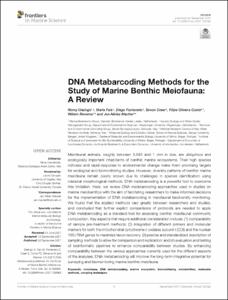| dc.contributor.author | Gielings, Romy | |
| dc.contributor.author | Fais, Maria | |
| dc.contributor.author | Fontaneto, Diego | |
| dc.contributor.author | Creer, Simon | |
| dc.contributor.author | Costa, Filipe Oliveira | |
| dc.contributor.author | Renema, Willem | |
| dc.contributor.author | Macher, Jan-Niklas | |
| dc.date.accessioned | 2022-08-12T18:16:12Z | |
| dc.date.available | 2022-08-12T18:16:12Z | |
| dc.date.issued | 2021 | |
| dc.identifier.citation | Gielings, R., Fais, M,. Fontaneto, D., Creer ,S., Costa, F.O., et al (2021) DNA Metabarcoding Methods for the Study
of Marine Benthic Meiofauna: A Review. Frontiers in Marine Science, 8:730063, 13pp. DOI: 10.3389/fmars.2021.730063 | en_US |
| dc.identifier.uri | https://repository.oceanbestpractices.org/handle/11329/2052 | |
| dc.description.abstract | Meiofaunal animals, roughly between 0.045 and 1 mm in size, are ubiquitous and
ecologically important inhabitants of benthic marine ecosystems. Their high species
richness and rapid response to environmental change make them promising targets
for ecological and biomonitoring studies. However, diversity patterns of benthic marine
meiofauna remain poorly known due to challenges in species identification using
classical morphological methods. DNA metabarcoding is a powerful tool to overcome
this limitation. Here, we review DNA metabarcoding approaches used in studies on
marine meiobenthos with the aim of facilitating researchers to make informed decisions
for the implementation of DNA metabarcoding in meiofaunal biodiversity monitoring.
We found that the applied methods vary greatly between researchers and studies,
and concluded that further explicit comparisons of protocols are needed to apply
DNA metabarcoding as a standard tool for assessing benthic meiofaunal community
composition. Key aspects that require additional consideration include: (1) comparability
of sample pre-treatment methods; (2) integration of different primers and molecular
markers for both the mitochondrial cytochrome c oxidase subunit I (COI) and the nuclear
18S rRNA genes to maximize taxon recovery; (3) precise and standardized description of
sampling methods to allow for comparison and replication; and (4) evaluation and testing
of bioinformatic pipelines to enhance comparability between studies. By enhancing
comparability between the various approaches currently used for the different aspects
of the analyses, DNA metabarcoding will improve the long-term integrative potential for
surveying and biomonitoring marine benthic meiofauna. | en_US |
| dc.language.iso | en | en_US |
| dc.rights | Attribution 4.0 International | * |
| dc.rights.uri | http://creativecommons.org/licenses/by/4.0/ | * |
| dc.subject.other | Meiofauna | en_US |
| dc.subject.other | DNA metabarcoding | en_US |
| dc.subject.other | Biomonitoring | en_US |
| dc.subject.other | Meiobenthos | en_US |
| dc.subject.other | Molecular methods | en_US |
| dc.subject.other | Sampling techniques | en_US |
| dc.title | DNA Metabarcoding Methods for the Study of Marine Benthic Meiofauna: A Review. | en_US |
| dc.type | Journal Contribution | en_US |
| dc.description.refereed | Refereed | en_US |
| dc.format.pagerange | 13pp. | en_US |
| dc.identifier.doi | 10.3389/fmars.2021.730063 | |
| dc.subject.parameterDiscipline | Other biological measurements | en_US |
| dc.bibliographicCitation.title | Frontiers in Marine Science | en_US |
| dc.bibliographicCitation.volume | 8 | en_US |
| dc.bibliographicCitation.issue | Article 730063 | en_US |
| dc.description.sdg | 14.a | en_US |
| dc.description.maturitylevel | Mature | en_US |
| dc.description.methodologyType | Reports with methodological relevance | en_US |
| obps.contact.contactname | Jan-Niklas Macher | |
| obps.contact.contactemail | jan.macher@naturalis.nl | |
| obps.resourceurl.publisher | https://www.frontiersin.org/articles/10.3389/fmars.2021.730063/full | |
 Repository of community practices in Ocean Research, Applications and Data/Information Management
Repository of community practices in Ocean Research, Applications and Data/Information Management

